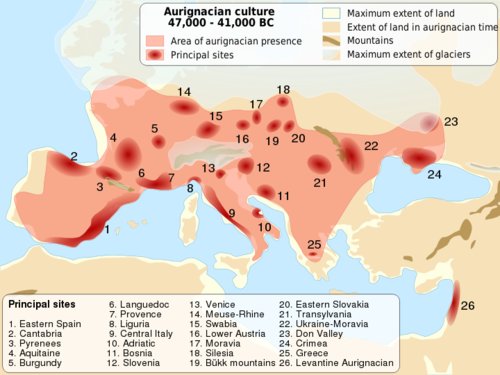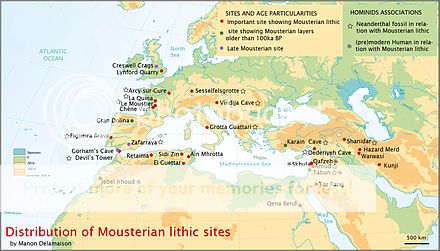It looks like you're using an Ad Blocker.
Please white-list or disable AboveTopSecret.com in your ad-blocking tool.
Thank you.
Some features of ATS will be disabled while you continue to use an ad-blocker.
12
share:
The team at the Max Plank institute has sequenced the genome of a 45,000 year old Siberian.
dienekes.blogspot.com...
Just a teaser from Ann Gibbons in Science:
In 2008, Siberian ivory carver Nikolay Peristov was searching for ancient mammotbyh tusks eroding from the banks of the Irtysh River in western Siberia, when he found fossilized bones instead. Back in his workshop in Omsk, he showed the bones to local paleontologist Aleksey Bondarev, who recognized a human thighbone. Bondarev in turn showed it to an anthropologist friend, and it was passed on up the chain to some of the world's top experts in human evolution. They dated it to 45,000 years ago, making it one of the oldest known modern humans in northern Asia and Europe.
Now, the bone has opened a window on the genetics of our species at a crucial moment: soon after their arrival in northern Eurasia. At a meeting* here last week, paleogeneticist Svante Pääbo of the Max Planck Institute for Evolutionary Anthropology in Leipzig, Germany, announced that his team has sequenced the thighbone's entire nuclear genome to high accuracy—an astonishing 42x coverage. "This is by far the oldest sequenced genome of a modern human," he said.
Because all living people in Europe and Asia carry roughly the same amount of Neandertal DNA, Pääbo's team thought that the interbreeding probably took place in the Middle East, as moderns first made their way out of Africa. Middle Eastern Neandertal sites are close to Skhul and Qafzeh, so some researchers suspected that those populations were the ones that mingled. But the team's analysis favors a more recent rendezvous. The femur belonged to an H. sapiens man who had slightly more Neandertal DNA, distributed in different parts of his genome, than do living Europeans and Asians. His Neandertal DNA is also concentrated into longer chunks than in living people, Pääbo reported. That indicates that the sequences were recently introduced: With each passing generation, any new segment of DNA gets broken up into shorter chunks as chromosomes from each parent cross over and exchange DNA. Both features of the Neandertal DNA in the femur suggest that the Ust-Ishim man lived soon after the interbreeding, which Pääbo estimated at 50,000 to 60,000 years ago.
The higher Neandertal DNA in the Ust-Ishim sample might be explainable by the negative selection against Neandertal material recently documented. At 45kya, this sample is right around the time of the Early Upper Paleolithic at Kara-Bom in Siberia (and indeed anywhere), so this will be a hugely interesting sample when it is finally published.
Here is the program of the symposium on which this was apparently discussed (pdf). There seem to be quite a few interesting titles
dienekes.blogspot.com...
edit on 28-3-2014 by punkinworks10 because: (no reason given)
edit on 28-3-2014 by punkinworks10 because: (no reason
given)
It would seem strange that the superior biological systems of modern humans would only be 45000 years old. I guess that this 45000 years is just the
oldest one Found, it means nothing. Modern Humans have been around for much longer than that.
reply to post by rickymouse
It's the oldest modern human genome sequenced not the oldestodern human.
The significance is that this individual is closer to the neanderhal / AMH crossbreeding episode.
It's the oldest modern human genome sequenced not the oldestodern human.
The significance is that this individual is closer to the neanderhal / AMH crossbreeding episode.
reply to post by rickymouse
the significance of this find is twofold. As punkinworks noted, it is the oldest MH remains sequenced thus far and second, it is profound for both the area it was found(Siberia) as well as the degree of shared DNA between MH and HN. It gets even more interesting, for me at least, because the specific period of time is within the overlap of Neandertal, Modern Human and Denisovan all living simultaneously as well as being contemporary with European Aurignacian culture. It will be interesting to see what further studies show regarding relationships with both Aurignacian's and North American Paleo-Indian who lived on and or crossed Beringea into N. America as well as lineage with our distant cousins. I added a map of known Aurignacian sites, none of which are farther East than Ukraine or Crimea mostly because the time period is contemporary with this find so it gives a little more context.

the significance of this find is twofold. As punkinworks noted, it is the oldest MH remains sequenced thus far and second, it is profound for both the area it was found(Siberia) as well as the degree of shared DNA between MH and HN. It gets even more interesting, for me at least, because the specific period of time is within the overlap of Neandertal, Modern Human and Denisovan all living simultaneously as well as being contemporary with European Aurignacian culture. It will be interesting to see what further studies show regarding relationships with both Aurignacian's and North American Paleo-Indian who lived on and or crossed Beringea into N. America as well as lineage with our distant cousins. I added a map of known Aurignacian sites, none of which are farther East than Ukraine or Crimea mostly because the time period is contemporary with this find so it gives a little more context.

It would seem a little weird living in a time where there were three or four types of hominoids living at the same time. I suppose they were used to
seeing other humans. I wonder what they called each other.
"Hey, quit hanging around with your crony friends, why can't you be civilized
"Quit acting like a big ape."
" You're a conehead"
And that is just a few things my Ex said to me
"Hey, quit hanging around with your crony friends, why can't you be civilized
"Quit acting like a big ape."
" You're a conehead"
And that is just a few things my Ex said to me
reply to post by peter vlar
Hi there peter
I can't help but notice how closely aurignacian overlays moustrian.

Hi there peter
I can't help but notice how closely aurignacian overlays moustrian.

edit on 29-3-2014 by punkinworks10 because: (no reason given)
reply to post by punkinworks10
Well I think you and I have some pretty similar thoughts on hominid dispersement during the Paleolithic. I personally think that Aurignacian culture was at least of Neanderthal inception if not entirely their culture. Look at some of the artwork found in Germany, particularly items and sites associated with the Hohlenstein-Stadle Lionman. There is a marked difference between slightly older finds at a separate cave containing sculptures done in mammoth tusks as well as flutes compared to the more refined later LionMan. Aurignacian just happens to occur at that moment of cohabitation and immigration of MH into Europe and that overlap to me shows signs of both HN and MH with the HN more prominent in earlier strata so the very close overlap of Mousterian and Aurignacian makes perfect sense in my never humble opinion. Is also not too far removed from verified cohabitation sites in the levant where we see a similar disparity of tool making and sophistication, though in reverse as in the Levant the HN gear is somewhat surprisingly more advanced than that of the MH coming into the Middle East from Africa.
Well I think you and I have some pretty similar thoughts on hominid dispersement during the Paleolithic. I personally think that Aurignacian culture was at least of Neanderthal inception if not entirely their culture. Look at some of the artwork found in Germany, particularly items and sites associated with the Hohlenstein-Stadle Lionman. There is a marked difference between slightly older finds at a separate cave containing sculptures done in mammoth tusks as well as flutes compared to the more refined later LionMan. Aurignacian just happens to occur at that moment of cohabitation and immigration of MH into Europe and that overlap to me shows signs of both HN and MH with the HN more prominent in earlier strata so the very close overlap of Mousterian and Aurignacian makes perfect sense in my never humble opinion. Is also not too far removed from verified cohabitation sites in the levant where we see a similar disparity of tool making and sophistication, though in reverse as in the Levant the HN gear is somewhat surprisingly more advanced than that of the MH coming into the Middle East from Africa.
new topics
-
Scary video of face in an abandoned house
Paranormal Studies: 1 hours ago -
Just Came Across These Unusual Old UFO Pics
Aliens and UFOs: 3 hours ago -
LA Mayor Bass Demanded $49M in Additional LAFD Cuts One Week Before Wildfires
Mainstream News: 5 hours ago -
Sepultura - Territory - With New Drummer Greyson Nekrutman
Music: 6 hours ago -
Carry On!
Short Stories: 7 hours ago
top topics
-
This should be plastered all over the airwaves
Mainstream News: 12 hours ago, 23 flags -
LA Mayor Bass Demanded $49M in Additional LAFD Cuts One Week Before Wildfires
Mainstream News: 5 hours ago, 17 flags -
Archbisop Vigano Warns of Deep State and Deep Church
New World Order: 14 hours ago, 16 flags -
Oh, Good Gosh. “Kremlin Warns Stay Away from Greenland.”
World War Three: 14 hours ago, 11 flags -
Just Came Across These Unusual Old UFO Pics
Aliens and UFOs: 3 hours ago, 4 flags -
Carry On!
Short Stories: 7 hours ago, 3 flags -
Sepultura - Territory - With New Drummer Greyson Nekrutman
Music: 6 hours ago, 2 flags -
Scary video of face in an abandoned house
Paranormal Studies: 1 hours ago, 2 flags
active topics
-
Los Angeles brush fires latest: 2 blazes threaten structures, prompt evacuations
Mainstream News • 368 • : WeMustCare -
Trump says ownership of Greenland 'is an absolute necessity'
Other Current Events • 161 • : Imhere -
Dr. Demento
Music • 16 • : baddmove -
Statements of Intent from Incoming Trump Administration Members - 2025 to 2029.
2024 Elections • 64 • : WeMustCare -
This should be plastered all over the airwaves
Mainstream News • 54 • : fringeofthefringe -
Archbisop Vigano Warns of Deep State and Deep Church
New World Order • 9 • : CosmicFocus -
Post A Funny (T&C Friendly) Pic Part IV: The LOL awakens!
General Chit Chat • 8015 • : baddmove -
Carry On!
Short Stories • 2 • : JJproductions -
Scary video of face in an abandoned house
Paranormal Studies • 0 • : ColeYounger2 -
Oh, Good Gosh. “Kremlin Warns Stay Away from Greenland.”
World War Three • 30 • : ARM19688
12
